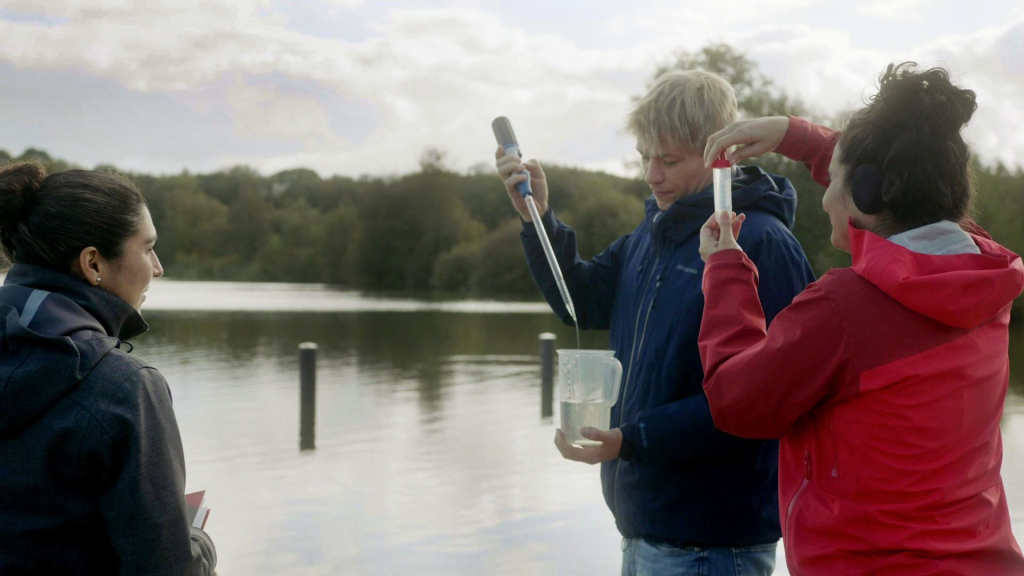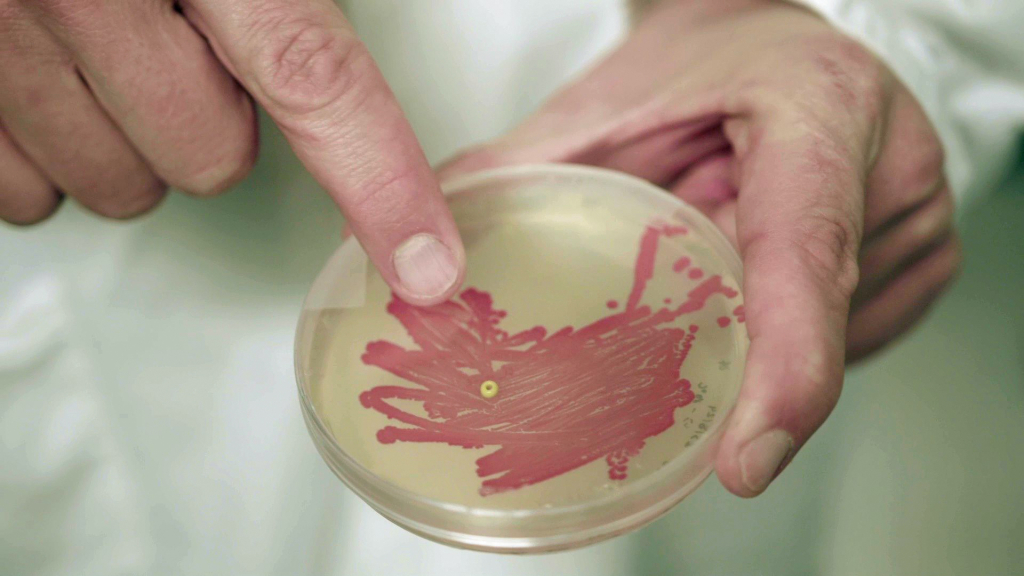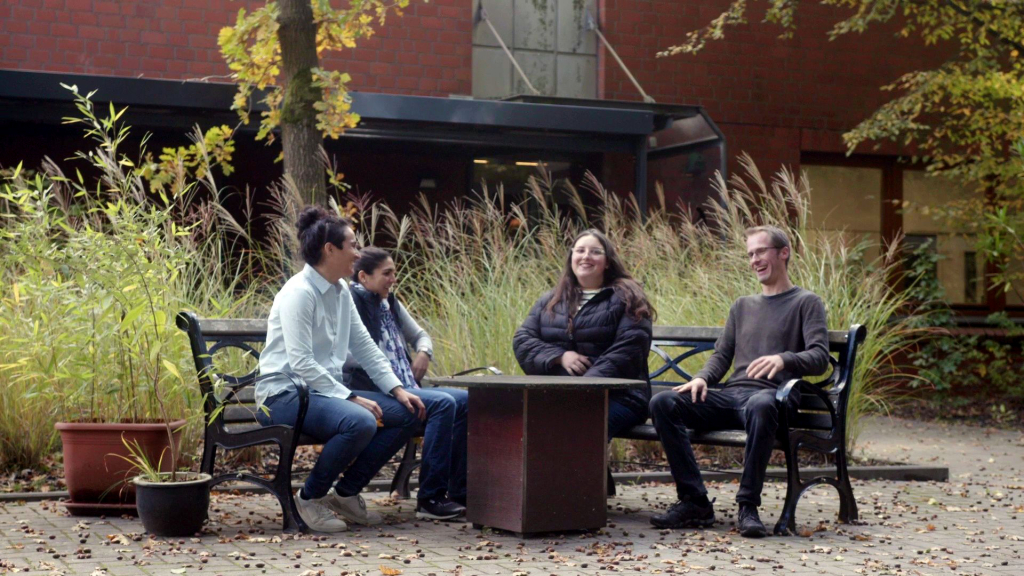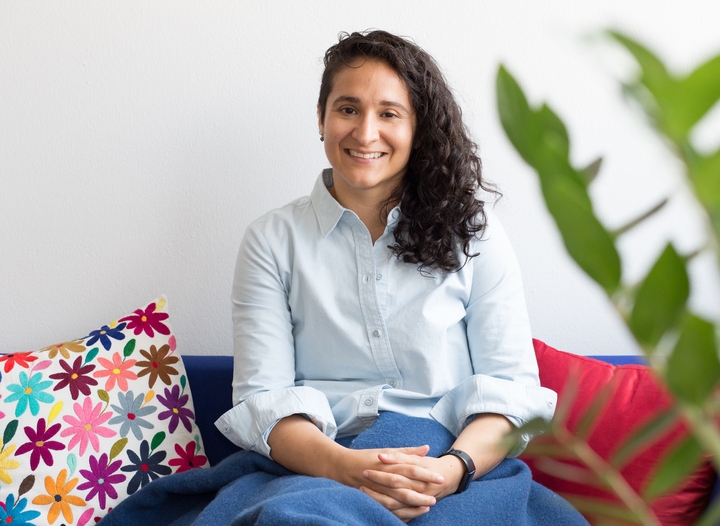It is a cool, cloudy September morning. Prof. Dr. Sarahi Garcia closes the window and drapes a blue rug around her legs. The microbiologist welcomes me to her office at the University of Oldenburg. White walls, a desk, a blue sofa; the view out of the window is of the inconspicuous neighbouring building. ‘I’m actually on holiday,’ she says with a wink, describing her idiosyncratic interpretation of recreation time, “holiday Sarahi style”: ‘I work until midday and then go to the gym for two to three hours before picking up the children.’
She was already a passionate gymnast as a teenager. At times, the Mexican with the black curls, shaved short above her right temple, earned her living as a coach. She later became a judge at gymnastics events. ‘I had a reputation for being a particularly fair judge,’ she says. While she was still studying bioprocess engineering in northern Mexico, Garcia was asked if she wanted to be a judge at national competitions. Instead, the then 20-year-old decided to pursue a career as a scientist. A master’s degree and then a doctorate offered her more exciting prospects. ‘As a judge, I would hardly have been able to develop further,’ she says. ‘I didn’t so much choose science as I did the challenge.
You are currently viewing a placeholder content from Youtube. To access the actual content, click the button below. Please note that doing so will share data with third-party providers.
More InformationDiversity - What we can learn from bacteria: A video portrait of Sarahi Garcia
ehrenwerk.tv für VolkswagenStiftung
Interactions in focus
In 2008, she moved to Georgia in the USA. Her plane ticket was paid for by a mentor who recognised the potential of the young woman from a humble background and encouraged her to take the step. He asked her to be sure of one thing, though: to pass on the support he had given her to others. At the time, she thought she would come back one day – perhaps as a teacher. ‘I arrived in the USA with just one suitcase,’ Garcia recalls. In it: her favourite blue blanket. ‘It even had a nickname: Azul Imenso – the big blue one.’ The big blue one fell by the wayside somewhere during Garcia’s numerous moves around the globe. She still loves blue blankets to this day.
In her master’s programme at the University of Georgia, she worked on producing fuels from carrot waste. ‘You need microbes for this,’ says Garcia, ‘primarily bacteria. And in the course of my work, their interactions came to my attention in a completely new way.’ The young researcher realised that plants and animals only make up a tiny part of the Earth’s biodiversity. ‘There are countless microorganisms on every single leaf, in every drop of seawater,’ she explains. ‘In Georgia, I started to take a closer look at how they interact.’

ehrenwerktv für VolkswagenStiftung
Garcia (r.) and her research group primarily study bacteria in aquatic environments with a focus on the carbon cycle and how the diversity of bacteria interacts and collaborates in the aquatic environment.
Diversity creates resilience
This interest motivated her to write her doctoral thesis in Jena and later to conduct research in the USA and Sweden. Despite all the misgivings she repeatedly had as to whether a Mexican woman from a humble background would be able to find a place in science at all, she worked her way forward step by step. She and her research partners have since developed their own theory of the function of microbial species communities, which she refers to as cohorts. ‘We think far too simplistically about diversity,’ she warns. This is also due to the fact that individual species of bacteria are usually observed in isolation and under highly simplified laboratory conditions. ‘But nature is enormously complex.’
Many bacteria or bacterial species cannot survive on their own, explains Garcia. ‘Only in the cohort do they complement each other at the level of basic needs.’ Diversity and interaction create community resilience. Garcia loves to think in such contexts. And she draws parallels, for example between microbial and human communities. She always wants to expand her observations to include other perspectives. ‘How exciting it would be to explore the connections between diversity and resilience in societies with philosophers and artists!’
Crazy? Or just particularly innovative?
To gain insights into the world of microbial interactions in the laboratory, Garcia and her colleagues cultivate bacteria from natural waters. ‘We generate random mixtures of different species and see which ones thrive when put together,’ she explains. Her method is in stark contrast to the usual approach of observing individual species in the laboratory under standardised conditions. As each of Garcia’s vials contains a unique mixture of species, the experiments cannot be repeated one-to-one. This, though, contradicts the scientific requirement for replicability of studies. ‘Some colleagues therefore think our approach is crazy,’ she says with a smile, ‘others think it’s just particularly innovative.’

ehrenwerktv für VolkswagenStiftung
Diversity instead of pure culture: In nature, microorganisms do not really live on their own. This is why Garcia and her team look at different microorganisms together in so-called model communities. For example, they are trying to understand which species provide vital vitamins or nutrients for their community.
Garcia and her colleagues are analysing the genetic material and metabolic products of successful bacterial communities. For example, they try to understand which species provide the vital vitamins or nutrients needed by their community. However, the results of their analyses are as heterogeneous as the bacterial mixtures studied. ‘Interpreting the genetic sequences together with the molecules that are produced and consumed is quite a challenge, to put it mildly,’ says Garcia. Her approach is therefore unusual for the research world in many respects. Perhaps this is why she was recently featured on the cover of a renowned scientific journal illustrating different approaches in modern microbiology.
Between science and religion
As a microbiologist, Garcia scrutinises the fundamental processes that determine life on Earth. ‘It was only through their interactions that bacteria made our planet habitable for higher organisms in the first place,’ she explains. ‘I find it fascinating to thinking about these beginnings of life.’ Reflection and discussions with colleagues have even opened up new approaches to religion for Garcia. ‘For me, religion is the path to meditation, to explore what lies beyond the explorable.’ Today, she has no problem to reconcile her scientific and spiritual views. But that wasn’t always the case. Influenced by the strict Christian environment of her childhood, for a longtime she wanted to become a missionary herself. Later, during her studies when she began to have doubts about religion, she was met with a lack of understanding; friendships and family ties were broken. ‘At that time, science was opening up new perspectives for me,’ she says.

ehrenwerktv für VolkswagenStiftung
Whether diversity or mental health, issues beyond pure research are also of great importance to Sarahi Garcia. She tries to give them appropriate space in her research group and teaching. "I want to accompany young people on their journey, inspire them and give them the tools to really take off and build a better future," says Garcia.
Sport as empowerment
With a career in academia, however, Garcia also took on the burden of multiple relocations. After completing her Master’s degree, she moved from Georgia to Jena, from there back to the USA for a postdoc position. In 2014, she arrived in Sweden, were she felt that she had found a home. She lived in Uppsala for longer than anywhere else, and a fellowship from the national SciLifeLab took her to Stockholm. Her children were born in Sweden. And it was there, after an episode of severe depression, that she discovered aerial acrobatics as a channel for relieving herself of tension. On her Instagram channel, she regularly posts photos and videos of her acrobatic moves on coloured hoops or silks hanging from the ceiling. ‘This sport is a great empowerment, especially for women,’ says Garcia, who soon started training others. And outside of sport, she is also a strong advocate of issues surrounding mental health – a sensitive topic, especially in the academic working world, which demands a lot from people.
A home for Sarahi Garcia?
And yet she said goodbye to her temporary adopted home once again. ‘It was a difficult decision. But it makes sense professionally,’ says Garcia. ‘Here at the Institute of Chemistry and Biology of the Marine Environment, I can continue my research in a permanent professorship.’ Returning to Mexico, as she had originally planned, is no longer an option. At the same time, it pains her greatly to be part of the brain drain in the country of her birth. ‘I never wanted that.’
After a year in Oldenburg, however, she can say that the family has settled in well. A sports club has even installed extra vertical hoops where Garcia teaches aerial acrobatics on Sunday mornings. Can the city in northern Germany now become a home for Sarahi Garcia – Mexican almost-missionary, world-travelled microbiologist, and aerial acrobat? ‘I’ve stopped looking for my home in just one place.’ In the past, a blue blanket offered the homesick student a piece of home. ‘Today, I want to find my home in what I do. I want to make a difference in other people’s lives.’ In line with her former mentor’s request to pass on his support, she is readily available to mentor her own Master’s and doctoral students. ‘I want to set them a good example so that they can find the self-love and self-confidence to pursue what they want to achieve.’



